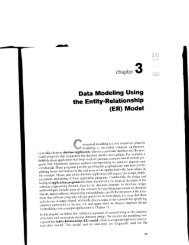13.1 through 13.5, 13.10 and 13.11
13.1 through 13.5, 13.10 and 13.11
13.1 through 13.5, 13.10 and 13.11
Create successful ePaper yourself
Turn your PDF publications into a flip-book with our unique Google optimized e-Paper software.
<strong>13.1</strong>0 Parallelizing Disk Access Using RAID Technologyture for indexing. In general, any data structure that can be adapted to the characteristicsof disk devices can be used as a primary file organization for record placementon disk.icularECTs,pe. In:tes ofrshipstxamc'sthet freld5 Owncords,valuelentedchicalrysical,orbyIisk tophysirently,ncy atMENTent, itJDENT:'ing of-'d file.s fieldllv thevpe ofdeter-.ta valrple,ifis offert'e ivillstruc- $<strong>13.1</strong>0 Parallelizing Disk AccessUsing RAID TechnologyWith the exponential growth in the performance <strong>and</strong> capacity of semiconductordevices <strong>and</strong> memories, faster microprocessors with larger <strong>and</strong> larger primary rxemoriesare continually becoming available. To match this growth, it is natural toexpect that secondary storage technology must also take steps to keep up withprocessor technology in performance <strong>and</strong> reliability.A major advance in secondary storage technology is represented by the developmentof RAID, which originally stood for RedundantArrays of Inexpensive Disks.Lately, the l in RAID is said to st<strong>and</strong> for Independent. The RAID idea received a verypositive industry endorsement <strong>and</strong> has been developed into an elaborate set ofalternative RAID architectures (RAID levels 0 <strong>through</strong> 6). We highlight the mainfeatures of the technology belowThe main goal of RAID is to even out the widely different rates of performanceimprovement of disks againsthose in memory <strong>and</strong> rnicroprocessors.l2 While RAMcapacities have quadrupled every two to three years, disk access times are improvingat less than l0 percent per year, <strong>and</strong> disk transfer rates are improving at roughly 20percent per year. Drsk capacities are indeed improving at more than 50 percent peryear, but the speed <strong>and</strong> access time inrprovements are of a much smaller magnitude.Thble 13.3 shows trends in disk technology in terms of 1993 parameter values <strong>and</strong>rates of improvement, as well as where these parameters are in 2003.A second qualitative disparity exists between the ability of special microprocessorsthat cater to new applications involving video, audio, image, <strong>and</strong> spatial data processing(see Chapters 24 <strong>and</strong> 29 for details of these applications), with correspondinglack of fast access to large, shared data sets.The natural solution is a large array of sn-rall independent disks acting as a singlehigher-performance logical disk. A concept called data striping is used, which utilizesparallellsnr to improve disk performance. Data striping distributes data transparentlyover multiple disks to make them appear as a single large, fast disk. Figure<strong>13.1</strong>2 shows a file distriburedor striped over four disks. Striping improves overallI/O performance by aliowing multiple I/Os to be serviced in parallel, thus providinghigh overall transfer rates. Data striping also accomplishes load balancing amongdisks. Moreover, by storing redundar-rt information on disks using parity or someother error correction code, reliability can be improved. In Sections 13.3.1 <strong>and</strong>13.3.2, we discuss how RAID achieves the two important objectives of improvedreliability <strong>and</strong> higher performance. Section 13.3.3 discusses RAID organizations.'12. This was predicted by Gordon Bel to be about 40 percent every year between 1974 <strong>and</strong> 1984 <strong>and</strong>is now supposed to exceed 50 percent per year.














